#Prijedor
Explore tagged Tumblr posts
Text
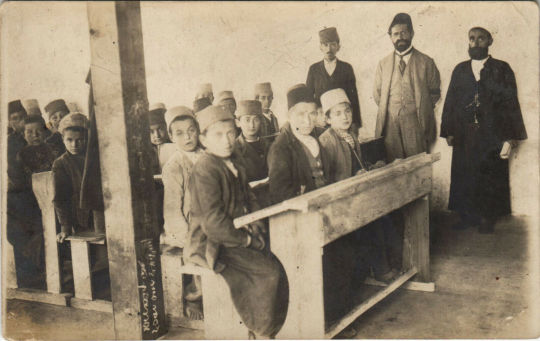
Class in the school of Prijedor, Bosnia and Herzegovina
Austrian vintage postcard
#postal#sepia#bosnia#ephemera#class#briefkaart#photo#school#photography#historic#postcard#prijedor#austrian#herzegovina#vintage#herzegovina austrian#postkaart#tarjeta#carte postale#postkarte#ansichtskarte
2 notes
·
View notes
Text

Shell of destroyed, burnt-out mosque
Shell of destroyed, burnt-out mosque (no caps), a casualty of war in former Yugoslav republic. (Photo by Robert Nickelsberg/Getty Images)
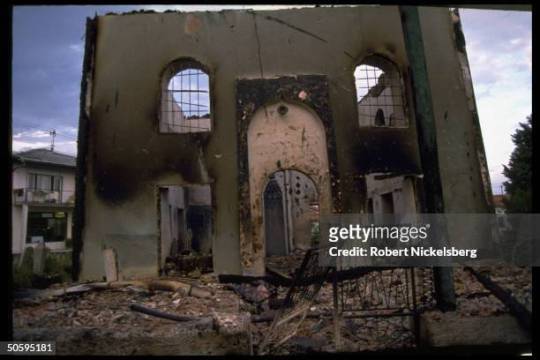
Shell of destroyed, burnt-out mosque (no caps), casualty of tri-ethnic (Muslim, Serb & Croat) civil war in former Yugoslav republic. (Photo by Robert Nickelsberg/Getty Images) Robert Nickelsberg
Date created: September 08, 1993
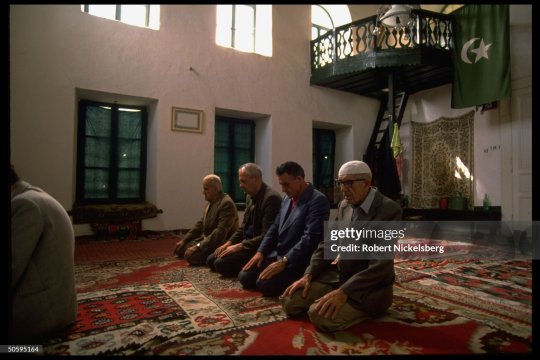
Muslim men at prayer (attended by 5) at Tale Mosque, 1 of city's oldest, hit by grenade in Aug. tri-ethnic civil war battle. (Photo by Robert Nickelsberg/Getty Images)
#mosque#history#bosnia#crimes#getty#ICTY#prijedor#Getty Images#Robert Nickelsberg#1990S#WAR#mosques#masjid#ISLAM
3 notes
·
View notes
Text
Otkud "Oluja " u Prijedoru?
Godišnjica ‘Oluje’ će biti sramno obilježena nad kostima ubijenih Prijedorčana Srpski Dan sjećanja na Oluju biće održan nad kostima ubijenih Bošnjaka i Hrvata Prijedora i prijedorske regije upravo zato što ova regija i jeste ogromno stratiše nesrba. Ovo je u konačnici potpuna inat-sprdnja s preko 3000 ubijenih od kojih su 102 djeteta. Ovo je kontinuitet negiranja zločina i genocida. Piše : Dragan…
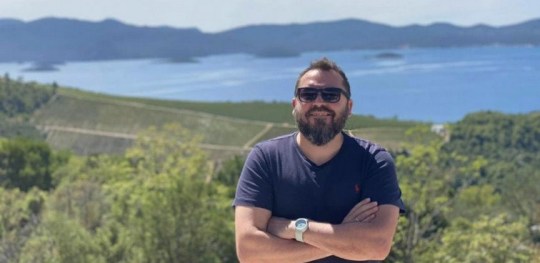
View On WordPress
3 notes
·
View notes
Text
We will never forget
0 notes
Text
Autobus sletio s puta, nekoliko putnika u bolnici
Foto: Avaz Nekoliko putnika danas je prevezeno je u bolnicu, nakon što je autobus sletio sa lokalnog puta u Petrovom gaju kod Prijedora, rečeno je u prijedorskoj Policijskoj upravi. Autobus koji je saobraćao redovnom linijom Prijedor-Petrov gaj sletio je u kanal pored puta. Saobraćajna nesreća policiji je prijavljena u 11:45 sati. Uzrok nesreće nije poznat. Izvor: Avaz

View On WordPress
0 notes
Text
I’ve made a (renewed) list of documentaries, lectures and other videos I’ve watched about Srebrenica
Documentaries
A cry from the grave
Srebrenica Genocide: No Room For Denial
ICTY remembers: Srebrenica genocide
Why Srebrenica had to fall
A deadly warning, Srebrenica revisited
The house Fata didn’t build
Women who refuse to die
Channels
Remembering Srebrenica channel on YouTube with many short videos
FAMA methodology channel - has many short videos and lectures
Lectures
Establishing the facts - Jean-Rene Ruez
The place of the Srebrenica massacre in the Bosnian genocide - Marko Attila Hoare
The role of the UN - Hasan Nuhanović
Genocide memorial day lecture (role of the UN) - Hasan Nuhanović
(the last two are important for understanding how the UN abandoned Srebrenica and contributed to the massacre)
Drone footage of Potočari from above, just so you can see how the Memorial Center now looks.
Bosnian only, no translation
Daleko je Tuzla
Putevi spasa
Zbijeg - priča Hasana Nuhanovića
Zločin i kazna - Srebrenica
Preživjeli
Nesmireni snovi
And here is a lengthy but detailed and well written text on why a revisionist documentary called “A town betrayed” is not a good source to learn about what happened in Srebrenica.
In addition, there are separate posts about Višegrad and Prijedor.
#a repost from my old blog but with fixed links#since the old post had too many broken ones#links for višegrad and prijedor lead to sanela's blog. i'm hoping she never deletes it#link for the article is the most important one and it was broken on the old post bc for some reason mirza deleted his blog and wordpress#srebrenica#bosnian genocide#bosnia and herzegovina#podrinje#arhiv
337 notes
·
View notes
Note
Why you hate bosniaks?
Lava vomit from the depths of Balkan hell, uncultured pigs and so on. Not whole BiH, I’m talking about the Bihać - Sarajevo - Prijedor - Bosanski brod rectangle. Delete from the face of the earth. Herzegovians (Croats) can live
4 notes
·
View notes
Text
I think I will take a few days off of the internet. Today's visit to Prijedor destroyed me ngl...
6 notes
·
View notes
Text
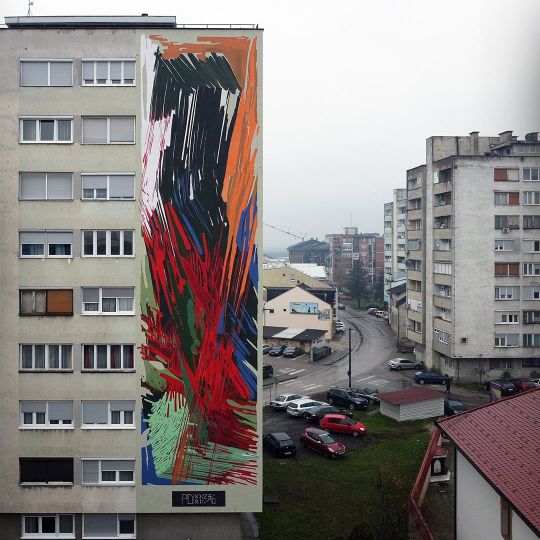
Streetart by Nikola Mihajlović @ Prijedor, Bosnia and Herzegovina, for Prijedor-grad Murala
More pics at: https://barbarapicci.com/2024/01/11/streetart-nikola-mihajlovic-prijedor-bosnia-and-herzegovina/
2 notes
·
View notes
Text
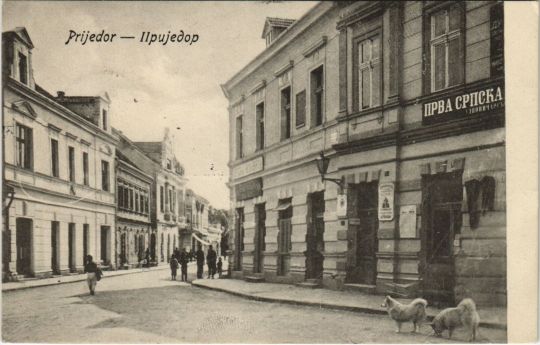
Street scene in Prijedor, Bosnia and Herzegovina
Austrian vintage postcard
#prijedor#austrian#carte postale#sepia#herzegovina#photo#postkarte#tarjeta#ansichtskarte#street#postkaart#herzegovina austrian#ephemera#scene#postcard#vintage#historic#postal#briefkaart#bosnia#photography
2 notes
·
View notes
Video
youtube
What do you know about White armband day in #prijedor #bosnia, 1992 - Dr Eman Tahawy / @drsonnet09
PDF file: https://www.slideshare.net/DrEmanTahawy/white-armband-day-bosniapdf
1992-1996: (Prijedor) 3.176 people were killed in Prijedor and the surrounding towns. Around 30.000 people of non-Serbian nationality also passed through Prijedor’s Trnopolje, Omarska, and Keraterm camps. TAGS: History, Srebrenica, Srebrenica massacre, PAINTING,WW1, BOSNIA, Bosnian genocide, genocide, forensic investigations, ICTY, UK, SCOTLAND, peace, Bosnia 1990s, antiwar movement, education of painting, Robert McNeil MBE,GRAVE FACES, THE HAGUE,1995, THE BALKANS, Majke Srebrenica, SREBRENICA, Žepe, MASS GRAVES, VODCAST, PODCAST,SREBRENICA MEMORIAL, Srebrenica Memorial Center, Srebrenica Genocide Denial,1992-1995 war, reconciliation
3 notes
·
View notes
Text
Provokacija u Prijedoru
Provokacija u Prijedoru za Dodikov ćeif Namjernom i vješto osmišljenom provokacijom, Dodik je zajedno sa predsjednikom Srbije Aleksandrom Vučićem poslao poruku da je srpska vojska i policija konačno u RS-u, odnosno u Bosni i Hercegovini. Piše: Nenad Kulačin Još jednom je Aleksandar Vučić uspeo da dodatno isprovocira situaciju u regionu, a onda da se pravda poput sirotih malih hrčaka. Malo toga bi…
0 notes
Text
~"Arrivals and Departures" exhibition~
🎥 Activity title: "Arrivals and Departures" exhibition
🎥 Duration and Amount: October 19th, two hours
🎥 Type of activity: creativity

~ Activity Description ~
The students of Visual Arts went to see the "Arrivals and Departures" exhibition that was being held at Banja Luka's Museum of Contemporary Art. The exhibition's author is Mladen Bundalo, an interdisciplinary artist born in Prijedor who has moved away and now lives in Belgium. Through his works, he wished to capture the transience of life, as well as childhood nostalgia, and the effect they have on one's current and future identity.
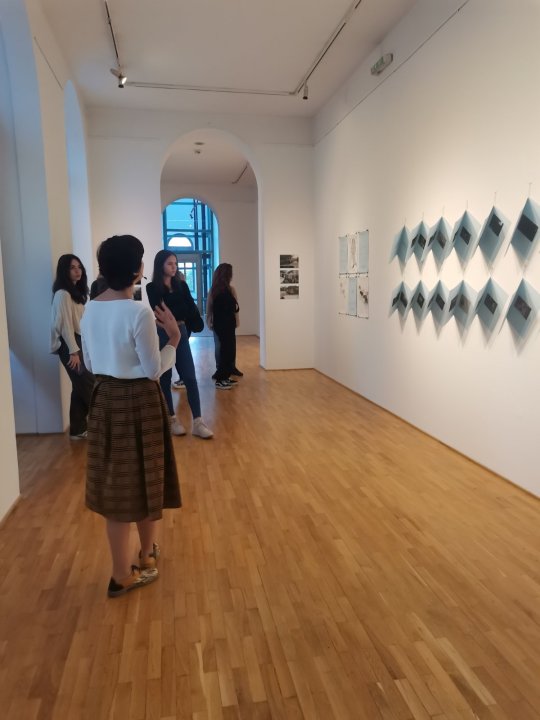
We were introduced to Isidora, a friend of the author who worked on this project along with him. She provided us with background information on how these works came to be and told us a bit more about the idea behind each work. She also told us that the name of the exhibition was a play on words, since the museum we were in was once a railway station.
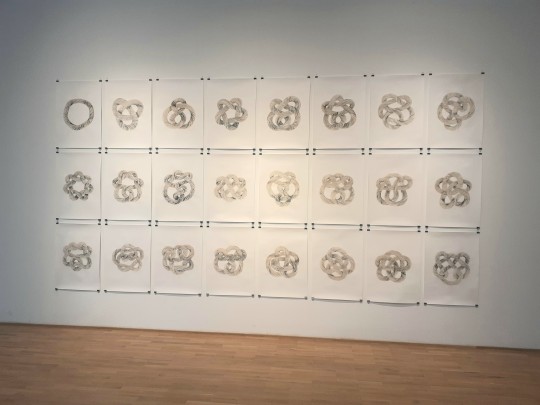
The first work we were introduced to was "Knots", which consisted of a bunch of different, framed knot designs. This work came about from the fact that there is not a single knot that is the same; every knot that we tie comes out differently. For me, this work represents the different paths we take in life and how they all enrich us in some way.
The poem "Universe" explains this work even further.
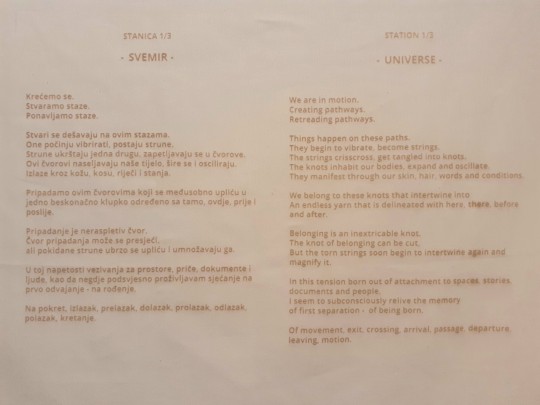
This four-player chessboard was handmade by the author. It's hardly noticeable, but there is a faint line cutting through the middle. Though it was an accident, it worked in the author's favor since he ended up really liking it, which is why he kept it. The pieces are movable, so if anyone wishes to play chess while they're there, they're free to do so.
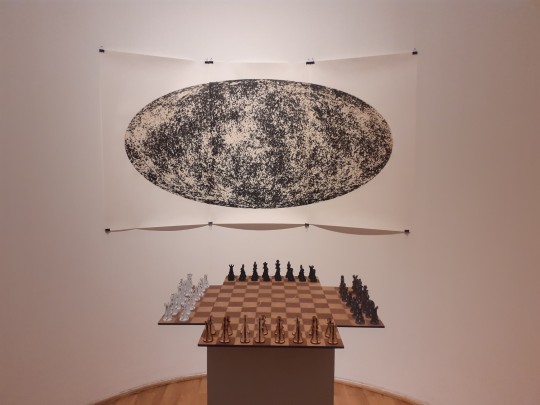
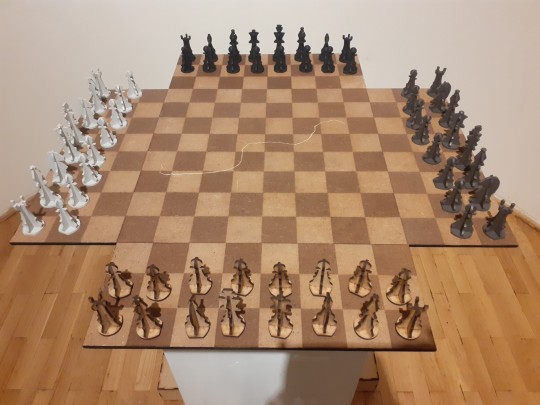
There was one other interactive work that those who attended the exhibition on the opening evening had the chance to participate in. There were 50 pieces of white fabric on which everyone was to draw their ideal world — a perfect place for living. Each piece of fabric was then placed on a separate wooden pole, which resulted in 50 different flags.
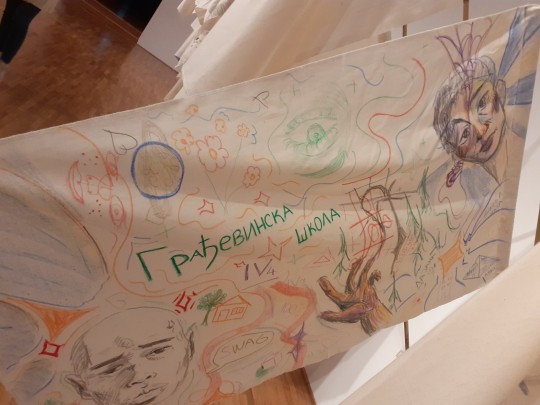
We had the opportunity to watch a movie about the author's life. The movie contained bits and pieces of not only his life but also parts of his friends and family's lives. It was made up of a number of clips; some of them were in his mother tongue, while others were in French. One clip that was comical but also a bit horrific was the one in which he, along with his wife, who is from Belgium, had to prove their marriage was real to the legal authorities. From the way it was presented, it seemed like a traumatic experience to be continuously doubted and questioned about whether you truly love someone you consider family.
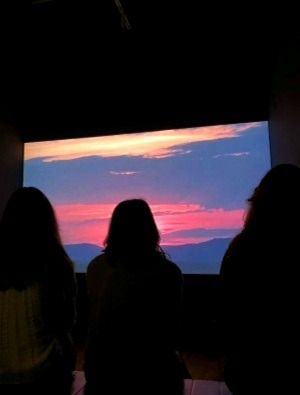
This next work was one of the most difficult ones to make since it required a real bus. Not only that, the piece had to be cut perfectly so that it would fit. They also had to make it look good, which was not easy considering the fact that they used a damaged vehicle. There was a film being projected on the wall next to the windows, so we were able to watch it while seated, giving us a feeling as if we were traveling along with the moving pictures.
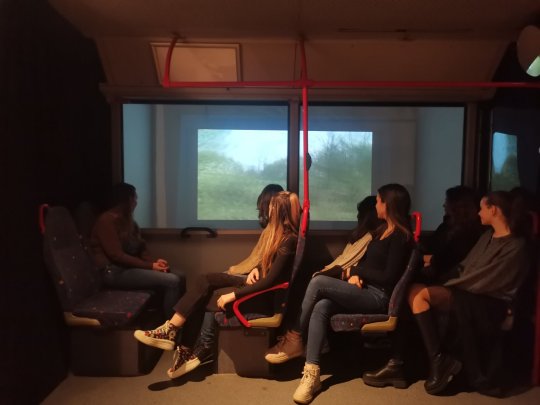
~ Reflection ~
This exhibition definitely hits close to home. Having had close family members move away while I was still young, I'm not unfamiliar with migrations and how they can affect a person's well-being, especially if they're moving far away from their family. It's usually accompanied by a deep sense of nostalgia as well as homesickness for things that we usually take for granted. I think everyone should visit this exhibition, especially the younger generations, since it is related to them. There will come a day when we experience true longing for something or someone. But there's nothing to fear since we're bound to find another path that will lead us somewhere new or lead us back home. To a place where we belong.

~ Learning Outcomes ~
🎥 Demonstrate how to initiate and plan a CAS experience
🎥 Show commitment to and perseverance in CAS experiences
🎥 Demonstrate engagement with issues of global significance
3 notes
·
View notes
Text
A Serbian communications agency has apologised after it used a photo of Bosniak refugees for an event in the northern Bosnian town of Prijedor commemorating Serb victims of a 1995 Croatian military operation.
Serbian President Aleksandar Vucic and the president of Bosnia’s predominantly Serb-populated Republika Srpska entity, Milorad Dodik, addressed the event in Prijedor on Friday evening marking the anniversary of the Croatian offensive ��Storm’ at the end of the 1991-95 Croatian war that swept away a rebel Serb statelet and put an estimated 200,000 Serbs to flight.
But among the videos and photos used as a backdrop was a photo by Agence France-Presse photographer Joel Robine of a Bosniak woman, Sabina Mujkic, holding her infant daughter on a bus fleeing the Bosnian village of Zepa in July 1995 in the wake of the massacre of some 8,000 Muslim men and boys by Bosnian Serb forces in and around Srebrenica.
In a statement late on Sunday, the communications agency, Pozitiv, said it took “full responsibility for the unintentional mistake”.
“This omission was not made with the intention of hurting, disparaging or abusing anyone and we hope that everyone will accept our sincere apologies,” the agency said, according to the Bosnian Serb Broadcasting Service.
Nermina Mujkic Guso, who was pictured as an infant in her mother’s arms, said the family was “in shock” after seeing how the photo was used.
“My mother reacted sadly, we are all sad, because it is ugly that it was done in such a way,” she told the Bosnian Avaz portal.
The Republika Srpska government blamed the “unintentional error” on the Serbian communications agency, which it said was contracted by Serbia’s Ministry of Work, Veterans and Disabled Protection to design the event. The Serbian ministry did not respond to a request for comment.
A total of 677 Serbs are believed to have died during and after the 1995 Croatian military offensive codenamed ‘Storm’, according to the Croatian Helsinki Committee.
This year’s commemoration was held in Prijedor, an area that is otherwise notorious as the location of detention camps run by Bosnian Serb forces during the 1992-95 war in Bosnia and where non-Serbs were interned, tortured, and, in many cases, killed.
The Youth Initiative for Human Rights, an NGO, condemned the decision to hold the event in Prijedor as a “coarse political manipulation of victims’ suffering in order to strengthen ethno-nationalist memory politics”.
4 notes
·
View notes
Text
Pjevač Halid Muslimović: Političarima iz Federacije nije odgovarao moj povratak u Prijedor
U vrijeme njegove ‘Halidomanije’ i u vrijeme nekadašnje Jugoslavije, Muslimović je pjevao skoro svaki dan u sedmici Halid Muslimović je, slobodno se može reći, jedan od bh. pjevača koji ima najviše snimljenih hitova, pjesama koje se i danas slušaju, a mnogi mladi pjevači snimaju covere na osnovu tih pjesama. U vrijeme njegove ‘Halidomanije’ i u vrijeme nekadašnje Jugoslavije, Muslimović je pjevao…

View On WordPress
#BiH#brzo#društvo#fotografija#Godine#Halid muslimović#inspiracija#karijere#Koncert#kuća#ljubav#ljudi#magazin#Muzika#Najnovije#Ostalo#pjesma#Pjevači#Povratak#sport#Srce#život
0 notes
Note
Selem Aleykum
I would like to do some research about the bosnian genocide . What was Europe's stance during that time?
We aleikum salam.
I can't think of a direct source that would answer that specific question right now, but what comes to mind are the following books:
The War is Dead, Long Live the War: Bosnia: The Reckoning by Ed Vulliamy, the first western journalist to visit and report on concentration camps in Prijedor in north-western Bosnia.
Under the UN Flag: The International Community and the Srebrenica Genocide by Hasan Nuhanović. He talks about the complicity of the International Community, and more specifically the UN Dutch battalion that was in charge of the Srebrenica "safe zone" when the enclave fell to Bosnian Serb forces. Nuhanović sued the state of the Netherlands for the deaths of his family members, mother, father and brother, who were expelled from the UN base where he was employed as a translator.
Speaking of the Dutch in Srebrenica, there is a photograph, that I can never forget for as long as I live, of a Dutchbat "peacekeeper" gleefully filming a group of Bosniaks picking through a pile of trash during a time of severe food scarcity and starvation for the people in the enclave. In my opinion, it's rather symbolic of Western Europe's stance towards Bosnia, then and now.
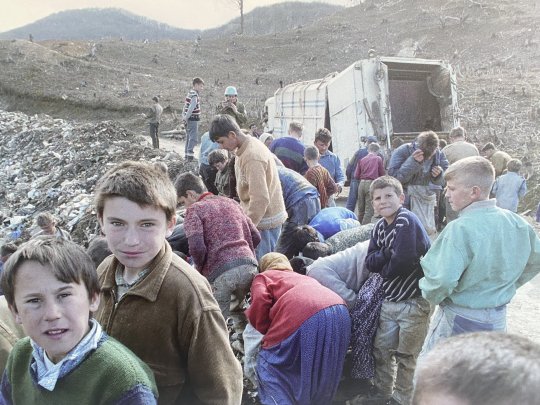

As I've said, not a direct answer to your question, but if you're doing research on this subject, these two books should be on your list regardless.
92 notes
·
View notes